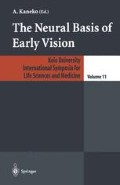Abstract
One stimulus that we detect very efficiently is a small square that just covers the dendritic field of a brisk-transient ganglion cell. Since this cell type is the most sensitive of the geniculo-striate projecting ganglion cells, it may largely mediate this behavior. To compare the neuron’s sensitivity to that of psychophysical detection, we measured its visual threshold with a method borrowed from psychophysics. Recordings were extracellular from a mammalian brisk-transient ganglion cell (guinea pig), whose impulse response was nearly identical to that of the primate brisk-transient cell. The stimulus, a 100-ms spot covering the receptive field center, was detected by an “ideal observer” with knowledge of the spike patterns from 100 trials at each contrast. Based on this knowledge, the ideal observer used a single-interval, forced-choice procedure to predict the stimulus contrast on 100 additional trials. Brisk-transient cells at 37°C detected contrasts as low as 0.8% (mean ± SEM = 2.8% ± 0.2) and discriminated between contrast increments with about 40% greater sensitivity. These thresholds are the same as human psychophysical thresholds for comparable stimuli, suggesting that across many levels of noisy central synapses, little or no information is lost. Recording intracellularly, we found the detection threshold of the ganglion cell’s graded potential to be about half that of the spike response, implying a considerable loss in converting the signals from analog to digital. To reach detection threshold, the ganglion cell needed ~1000 quanta, and to respond at full contrast, it needed ~2000 quanta. Since the ribbon synapses that contact this cell contain an aggregate of ~105 releasable vesicles, the safety factor for this circuit seems to be about 5.
Access this chapter
Tax calculation will be finalised at checkout
Purchases are for personal use only
Author information
Authors and Affiliations
Editor information
Editors and Affiliations
Rights and permissions
Copyright information
© 2003 Springer-Verlag Tokyo
About this paper
Cite this paper
Dhingra, N., Smith, R., Sterling, P. (2003). Psychophysics to Biophysics: How a Perception Depends on Circuits, Synapses, and Vesicles. In: Kaneko, A. (eds) The Neural Basis of Early Vision. Keio University International Symposia for Life Sciences and Medicine, vol 11. Springer, Tokyo. https://doi.org/10.1007/978-4-431-68447-3_1
Download citation
DOI: https://doi.org/10.1007/978-4-431-68447-3_1
Publisher Name: Springer, Tokyo
Print ISBN: 978-4-431-68449-7
Online ISBN: 978-4-431-68447-3
eBook Packages: Springer Book Archive

